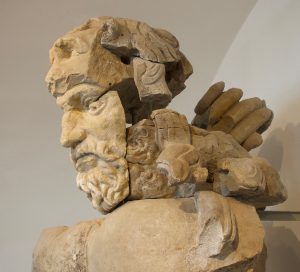
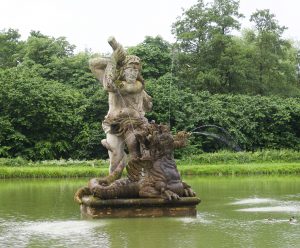
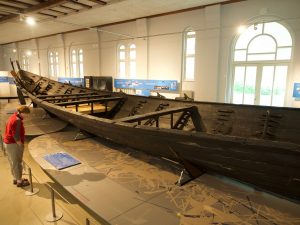
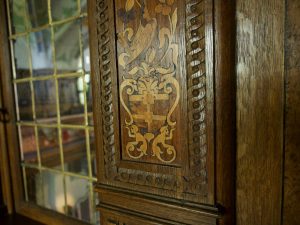
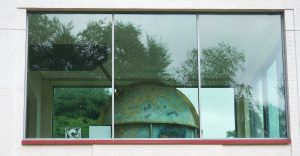
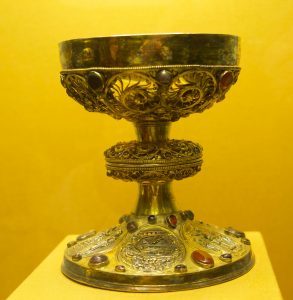
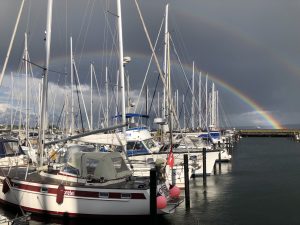
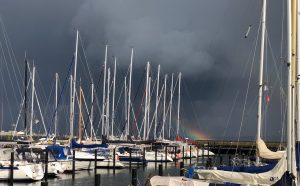
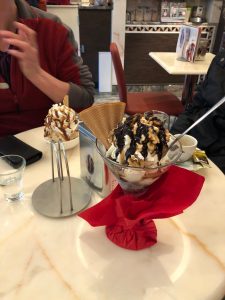
We got up at about 7:30, and Uschi, who was up a little bit before the other two, came over to chat for a little bit before Mark and I took off for today’s adventure a little after 9 am. The weather forecast for the day had looked pretty dismal (cold, rainy until the late afternoon), and we had decided we wanted to go to a museum that was mostly indoors, and then see whether we could add some good-weather activities later. So we drove to Schleswig, where the former dukes of Schleswig-Holstein-Gottorf used to rule until the early 18th century, from a palace/castle that now houses multiple museums curated by the state of Schleswig-Holstein. Schleswig is only half an hour from here, further inland, and we got to Schloss Gottorf just about 10 am when it opened. Since it wasn’t raining yet, we went to visit the gardens first—they are baroque-era gardens, but were apparently long in disarray and were just restored 10 years ago. They are very prettily terraced but were mostly designed with shrubbery and not that many flowers, so they pale in comparison with what we saw in Berlin. But there was an interesting sandstone sculpture of Hercules slaying the Hydra in the bottom-most lake—we found out later that it fell into the lake in the early 19th century and was left there until pieces were recovered in the 1990s and could be used for a reconstruction. The pieces were on display inside the museum along with other statuary from the original gardens. The gardens and the main portions of the castle all date from the mid-17th century, although the foundations date back to medieval times, and the 18th-century owners added some parts of building, which also had to be repaired after a major explosion in the 19th century, but sustained no damage during WWII.
We then went inside and started with the oldest stuff in the archeology museum: there is a famous Viking longboat on display that was excavated from the omnipresent bog of this region with all the wooden pieces intact, even as it had fallen apart. Technically, it was first found further north, in Nydam, in what is now Denmark, but at the time, the area we are in was Danish as well. The boat was displayed in various museums and now has its home in a really detailed display that shows how the pieces were actually found vs. how they were reassembled into a giant boat. They also showed some of the other, more recent archeological finds around the boat, including belt buckles etc. Then we continued along the same lines inside the main building, by looking at Iron Age and Bronze Age artifacts. The main finds in this area are urns with human remains, plus gifts that were added to many graves. Some of these were found in various types of megalith graves, others in urn cemeteries.
The biggest / most dramatic finds from this area, though, are the bog “mummies,” of which there are three in this museum. They were fascinating because of the way the peat preserves corpses in the moor, but I was intrigued mostly because I finally got a better sense of what the current archeological view on these is. „My“ idea of the bog people is derived from Seamus Heaney‘s famous poems, especially from „Punishment,“ which was inspired by 1960s-era ideas about a bog find of a young person, the Windeby Girl, now renamed „Windeby Child“ from a book that Heaney read. The idea that the dead person was a teenage girl probably killed as punishment for being an adulteress was Heaney‘s objective correlative for addressing the way „fraternizing“ women were treated during the Irish troubles, and his poem does this in a haunting and beautiful way. When I saw the Windeby „Girl“ it was hard not to have this going through my head—but archeologists now think that this child, 15 to 17 years old, probably died from an infected tooth in the lower jaw, and that this was perhaps a (rather unusual) burial. And they apparently really cannot tell the gender of this child; the DNA samples are ambiguous. And yet… the powerful poem holds great sway over me. The bog people, and a number of other older archeological finds we saw, all had the usual 19th century archeology problem—they were inexpertly treated and restored, so I actually walked away with a less clear sense of what bog corpses were really about than I had before. But the fact that fabric and hair was preserved by the peat in the moors is still pretty amazing.
After we had looked at the archeology portion of the museum, we went to have a little snack at the cafe in the castle/palace/residence (“Schloss” is so hard to translate). Their lunch was rather on the expensive side, so we just had something to drink and shared an excellent piece of apple cake. They also gave us a teeny piece of sweet (nougat / caramel crunch) that came free with our entrance fee. When we were ready to get back into the museum, it was pouring, and we had to rush back across the courtyard from one side of the building to the other to make sure we didn’t get too wet!
The ground floor for the art history / cultural history tour through the castle was fascinating, but also exhausting. It started with the Middle Ages and the Renaissance, and moved through the baroque and all the way to the early 20th century. We spent over two more hours there, trying to focus on a few items but a bit overwhelmed by the mass of things to look at—a mix of furniture and dishes with paintings, statues and altarpieces that was especially extensive fore the 17th century, and got pretty thin for the 19th, when most valuables from the castle were taken to the new Danish ruler‘s court in Copenhagen. Nonetheless, some things were fascinating. A list so that I don’t forget:
- the wood-carved baroque chapel with its prayer room that was all made from elaborately inlaid wood;
- the stucco ceilings in various rooms that had been restored, especially in the elaborate „Hirschsaal“—everything was a lot simpler than in Sanssouci, but in a way seemed more reasonable and a bit down to earth even when ornate;
- the recreated or „imported“ farmers‘ living rooms from various estates, with their dark paneling, their „box beds“ behind the paneling, and the big stoves with entire walls of tile behind them;
- some samples of Wedgewood ceramics, much more interesting to me now that I know a bit about Wedgewood from my art history class.
- a couple of paintings by Angelica Kaufmann, which I didn‘t expect find here (there were also some works by Cranach the Elder that I was impressed by, but more because he‘s famous than because I liked them.
- a totally surprising and very quiet gallery of Northern / local art nouveau on the second floor. Along the lines of the Broehan museum in Berlin, I really liked some of the art nouveau / Jugendstil furniture and dishes, especially some of the extensive work of an artist I had never heard of, Wenzel Havlik, who was apparently from Bohemia but settled here in the north.
- there was also an impressionist Northern (Danish?) painter named Hinrich Wrage who was new to me, but captured some of the coastal landscapes here very well.
We were pretty museumed out after that, and did not continue on to the outbuildings, where there would have been more modern art! Instead, we drove home in the rain, since the weather was no good for any walking around in the nearby city of Schleswig or for a nearby outdoor Viking museum. It only took us 30 minutes, so we were home by 4. We took a little bit of a rest (Mark took a nap), and then the others came to join us at 5:30. We ventured out to diner in between squalls (well, almost—we did get wet on the way, but were amply compensated by a fabulous double rainbow over the sailboats in the harbor!
Tonight, we had excellent tapas at a Spanish restaurant that Uschi had suggested (her treat). The food was lovely and the service wonderful, so we were very happy (what a contrast to yesterday!), and we even had room for gelato for dessert. After a little bit of roaming around, we found a gelateria downtown and had amazing concoctions—even though I ordered a smaller serving this time, it was still rather large. And yummy. Then we came back to the apartment and chatted a bit more, and Imke, Uschi, and Dorothee left around 9 pm to go back to their place. Mark and I went for a brief walk while the sun was still out (sunset: 9:57 pm) but even though the sky was clearing, it was chilly and windy, so we didn’t stay out long. We wrapped up our journaling and called it a night!
One thought on “Thursday, June 21 (Schleswig/ Schloss Gottorf)”